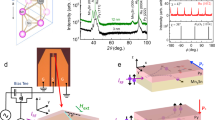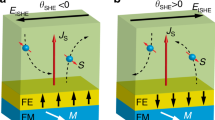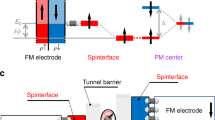Abstract
The Peltier coefficient describes the amount of heat that is carried by an electrical current when it passes through a material1. When two materials with different Peltier coefficients are placed in contact with one another, the Peltier effect causes a net flow of heat either towards or away from the interface between them. Spintronics2 describes the transport of electric charge and spin angular momentum by separate spin-up and spin-down channels in a device. The observation that spin-up and spin-down charge transport channels are able to transport heat independently of each other3 has raised the possibility that spin currents could be used to heat or cool the interface between materials with different spin-dependent Peltier coefficients. Here, we report the direct observation of the heating and cooling of such an interface by a spin current. We demonstrate this spin-dependent Peltier effect in a spin-valve pillar structure that consists of two ferromagnetic layers separated by a non-ferromagnetic metal. Using a three-dimensional finite-element model, we extract spin-dependent Peltier coefficients in the range −0.9 to −1.3 mV for permalloy. The magnetic control of heat flow could prove useful for the cooling of nanoscale electronic components or devices4.
This is a preview of subscription content, access via your institution
Access options
Subscribe to this journal
Receive 12 print issues and online access
$259.00 per year
only $21.58 per issue
Buy this article
- Purchase on Springer Link
- Instant access to full article PDF
Prices may be subject to local taxes which are calculated during checkout




Similar content being viewed by others
References
MacDonald, D. K. C. Thermoelectricity, An Introduction to the Principles (Dover, 2006).
Žutić, I., Fabian, J. & Das Sarma, S. Spintronics: fundamentals and applications. Rev. Mod. Phys. 76, 323–410 (2004).
Gravier, L., Serrano-Guisan, S., Reuse, F. & Ansermet, J-Ph. Spin-dependent Peltier effect of perpendicular currents in multilayered nanowires. Phys. Rev. B 73, 052410 (2006).
Giazotto, F., Heikkilä, T. T., Luukanen, A., Savin, A. M. & Pekola, J. P. Opportunities for mesoscopics in thermometry and refrigeration: physics and applications. Rev. Mod. Phys. 78, 217–274 (2006).
Bauer, G. E. W., MacDonald, A. H. & Maekawa, S. Spin caloritronics. Solid State Commun. 150, 459–460 (2010).
Uchida, K. et al. Observation of the spin Seebeck effect. Nature 455, 778–781 (2008).
Jaworski, C. M. et al. Observation of the spin-Seebeck effect in a ferromagnetic semiconductor. Nature Mater. 9, 898–903 (2010).
Uchida, K. et al. Spin Seebeck insulator. Nature Mater. 9, 894–897 (2010).
Slachter, A., Bakker, F. L., Adam, J-P. & van Wees, B. J. Thermally driven spin injection from a ferromagnet into a non-magnetic metal. Nature Phys. 6, 879–882 (2010).
Le Breton, J-C., Sharma, S., Saito, H., Yuasa, S. & Jansen, R. Thermal spin current from a ferromagnet to silicon by Seebeck spin tunneling. Nature 475, 82–85 (2011).
Hatami, M. & Bauer, G. E. W. Thermal spin-transfer torque in magnetoelectronic devices. Phys. Rev. Lett. 99, 066603 (2007).
Yu, H., Granville, S., Yu, D. P. & Ansermet, J-Ph. Evidence for thermal spin-transfer torque. Phys. Rev. Lett. 104, 146601 (2010).
Heikkilä, T. T., Hatami, M. & Bauer, G. E. W. Spin heat accumulation and its relaxation in spin valves. Phys. Rev. B 81, 100408(R) (2010).
Walter, M. et al. Seebeck effect in magnetic tunnel junctions. Nature Mater. 10, 742–746 (2011).
Liebing, N. et al. Tunneling magnetothermopower in magnetic tunnel junction nanopillars. Phys. Rev. Lett. 107, 177201 (2011).
Hatami, M., Bauer, G. E. W., Zhang, Q. & Kelly, P. J. Thermoelectric effects in magnetic nanostructures. Phys. Rev. B 79, 174426 (2009).
Slachter, A., Bakker, F. L. & van Wees, B. J. Modeling of thermal spin transport and spin–orbit effects in ferromagnetic/nonmagnetic mesoscopic devices. Phys. Rev. B 84, 174408 (2011).
Stiles, M. D. & Miltat, J. Spin Dynamics in Confined Magnetic Structures III, Topics in Applied Physics Vol. 101, 225–308 (Springer, 2006).
Bakker, F. L., Slachter, A., Adam, J-P. & van Wees, B. J. Interplay of Peltier and Seebeck effects in nanoscale nonlocal spin valves. Phys. Rev. Lett. 105, 136601 (2010).
Slachter, A., Bakker, F. L. & van Wees, B. J. Anomalous Nernst and anisotropic magnetoresistive heating in a lateral spin valve. Phys. Rev. B 84, 020412(R) (2011).
Tulapurkar, A. A. & Suzuki, Y. Boltzmann approach to dissipation produced by a spin-polarized current. Phys. Rev. B 83, 012401 (2011).
Dubois, S. et al. Evidence for a short spin diffusion length in permalloy from the giant magnetoresistance of multilayered nanowires. Phys. Rev. B 60, 477–484 (1999).
Steenwyk, S. D., Hsu, S. Y., Loloee, R., Bass, J. & Pratt, W. P. Jr Perpendicular-current exchange-biased spin-valve evidence for a short spin-diffusion length in permalloy, J. Magn. Magn. Mater. 170, L1–L6 (1997).
Acknowledgements
The authors thank B. Wolfs, M. de Roosz and J.G. Holstein for technical assistance and N. Vlietstra for initial pillar testing. This work is part of the research programme of the Foundation for Fundamental Research on Matter (FOM) and is supported by NanoLab NL, EU FP7 ICT (grant no. 257159 MACALO) and the Zernike Institute for Advanced Materials.
Author information
Authors and Affiliations
Contributions
J.F., F.L.B., A.S. and B.J.v.W. conceived the experiments. J.F. and F.L.B. designed and carried out the main experiments. J.F., F.L.B. and F.K.D. took part in the fabrication process. J.F. and F.L.B. performed the analysis and wrote the paper, with the help of all authors.
Corresponding author
Ethics declarations
Competing interests
The authors declare no competing financial interests.
Supplementary information
Supplementary information
Supplementary information (PDF 776 kb)
Rights and permissions
About this article
Cite this article
Flipse, J., Bakker, F., Slachter, A. et al. Direct observation of the spin-dependent Peltier effect. Nature Nanotech 7, 166–168 (2012). https://doi.org/10.1038/nnano.2012.2
Received:
Accepted:
Published:
Issue Date:
DOI: https://doi.org/10.1038/nnano.2012.2
This article is cited by
-
Chiral-phonon-activated spin Seebeck effect
Nature Materials (2023)
-
The role of spin in thermoelectricity
Nature Reviews Physics (2023)
-
Spin-thermoelectric effects in a quantum dot hybrid system with magnetic insulator
Scientific Reports (2022)
-
Progress of microscopic thermoelectric effects studied by micro- and nano-thermometric techniques
Frontiers of Physics (2022)
-
Real-space observations of 60-nm skyrmion dynamics in an insulating magnet under low heat flow
Nature Communications (2021)



